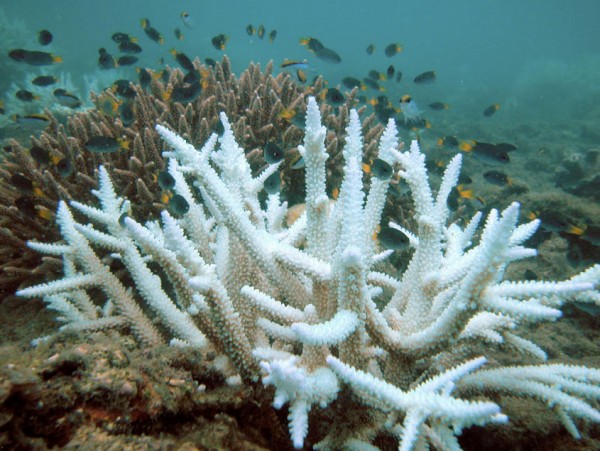Worst Coral Bleaching in 20 Years Could Occur in 2015
| Marco Foronda | | Dec 24, 2014 06:50 AM EST |
(Photo : wikipedia.org) Bleached branching coral (foreground) and normal branching coral (background), Keppel Islands, Great Barrier Reef.
Experts predict the worst coral bleaching in 20 years could occur in the next six to 12 months and it's being triggered by global warming.
Coral bleaching occurs when corals expel their "zooxanthellae," the algae-like protozoa that live in and on their tissue. This expulsion occurs because seawater either becomes too hot or too acidic.
Like Us on Facebook
Healthy corals are dependent on the unicellular organism for both the pigmentation it provides and its photosynthetic abilities. Bereft of its zooxanthellae, corals don't die but become more vulnerable to other environmental stressors and susceptible to disease. Corals also become unattractive to fish.
Coral reefs act as food and haven for various marine creatures like smaller fish and they also maintain diversity in the ocean.
Scientists said coral bleaching occurrences will increase in frequency and will be on a larger scale because sea water is heating up and is becoming more acidic.
"As the ocean becomes more acidified, the bleaching threshold for corals drops, more carbon dioxide makes corals more sensitive to thermal stress. Not only are we seeing more thermal stress but we're making them more sensitive at the same time," said Mark Eakin, head of National Oceanic and Atmospheric Administration's Coral Reef Watch program.
Massive coral bleaching only happens during El Niño events, a periodic warming phase in the Pacific that occurs every two to seven years. It lasts several months to a year and has a chain reaction of atmospheric and climatological events.
Now that ocean temperatures are close enough to an all-time peak, it's expected El Niño will trigger a domino effect of coral bleaching phenomena across global waters.
Researchers said coral bleaching will affect Florida, Hawaii, Guam, the Marianas Islands, Kiribati and Tuvalu. They expect to see it throughout the Pacific islands and along the shores of Australia.
The last and biggest bleaching event occurred in 1998 and was caused by El Niño in conjunction with global warming.
Ove Hoegh-Guldberg, a marine biology researcher at the University of Queensland, declared that many coral reef researchers anticipate something comparable to the event in 1997 to 1998 to unfold in the following six to 12 months.
Tagscoral reefs, Coral bleaching, global warming, drought, El Nino
©2015 Chinatopix All rights reserved. Do not reproduce without permission
EDITOR'S PICKS
-

Did the Trump administration just announce plans for a trade war with ‘hostile’ China and Russia?
-

US Senate passes Taiwan travel bill slammed by China
-

As Yan Sihong’s family grieves, here are other Chinese students who went missing abroad. Some have never been found
-

Beijing blasts Western critics who ‘smear China’ with the term sharp power
-

China Envoy Seeks to Defuse Tensions With U.S. as a Trade War Brews
-

Singapore's Deputy PM Provides Bitcoin Vote of Confidence Amid China's Blanket Bans
-

China warns investors over risks in overseas virtual currency trading
-

Chinese government most trustworthy: survey
-

Kashima Antlers On Course For Back-To-Back Titles
MOST POPULAR
LATEST NEWS
Zhou Yongkang: China's Former Security Chief Sentenced to Life in Prison

China's former Chief of the Ministry of Public Security, Zhou Yongkang, has been given a life sentence after he was found guilty of abusing his office, bribery and deliberately ... Full Article
TRENDING STORY

China Pork Prices Expected to Stabilize As The Supplies Recover

Elephone P9000 Smartphone is now on Sale on Amazon India

There's a Big Chance Cliffhangers Won't Still Be Resolved When Grey's Anatomy Season 13 Returns

Supreme Court Ruled on Samsung vs Apple Dispute for Patent Infringement

Microsoft Surface Pro 5 Rumors and Release Date: What is the Latest?










